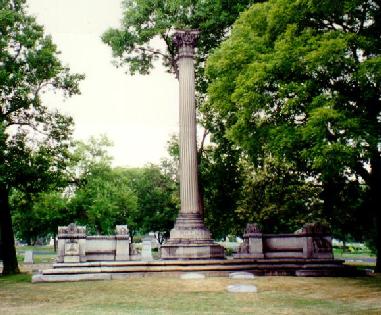Though once the site of corporate oppression and violence against workers and their families,
Chicago's Pullman neighborhood is shaping up to become the greatest place in the city to celebrate Labor Day in 2008.

Pullman's monument in Graceland Cemetery
The storm center of perhaps the most famous industrial conflict of
the 19th century was the charming and wholly owned planned community
where industrialist
George Pullman manufactured the sleeping cars. The charming Pullman area, on Chicago's far-southside, has a dark and troubled history.
The workers were forced to buy everything they needed from the "company store," where prices were fixed. At the end of many a month, workers would find that the food for their families cost more than the wages they were paid. They became virtual labor slaves to Pullman, because they owned so much to the company, they might never get out of debt. According to the website
Graceland Cemetery, When the fortunes of the company declined in 1894, Pullman
slashed wages by 25 percent. However, he neglected to lower the rents
or cost of groceries in the company town. A delegation of workers went
to meet with Pullman and ask him to reduce these costs – the next day,
these men were fired. His workers went on strike, aided by
Eugene Debs'
American Railway Union. Workers refused to handle any train with
Pullman cars attached. In order to ensure that the mail on those
trains would not be delayed,
President Cleveland sent federal troops to break the strike , over the protests of
Governor Altgeld. All Pullman
employees were then required to sign a statement that they would never
attempt to join a union.
George Pullman was so hated by the workers, that his body was kidnapped, and eventually had to be encased in tons of concrete as it was put into his elaborate memorial at Graceland Cemetery. This is only one of the episodes of often bloody and bitter confict between people who had to work for a living, and corporations, that culminated in securing an eight-hour work day for workers.
“
The Labor Trail: Chicago's History of Working-Class Life and Struggle ,” a map of 140 significant locations in the history of labor,
migration, and working-class culture in Chicago and Illinois, showcases the many generations
of dramatic struggles and working-class life in the Chicago area's rich
and turbulent past. Prominent on this map, is Pullman.
The Visitor’s Center offers artifacts to view and
mementos for sale. The Florence Hotel with its spacious verandah
provides an elegant physical and emotional centerpiece to the area. Although the factory is partially gone, the dramatic Clock Tower
remains and industrial artifacts from the vanished steel industry are
on display. The Hotel and factory property belong now to the Illinois
Historic Preservation Agency and can be toured by appointment The partly-restored factory/Clocktower building tours begin at 2:00 p.m.
at 11035 S. Cottage Grove Ave (111th St) on Labor Day, 2008.
On Labor Day, re-enactors will be on hand as historic personalities associated with labor struggles throughout
the years,

Replace this text with the caption
This year is the 75th anniversary of the New Deal, and it was then that Pullman plant employees were organized once again,
this time by the newly formed United Steelworkers of the CIO.
The free program is sponsored by the Pullman Civic Organization,
the Pullman Historic Foundation, the Illinois Labor History Society,
Illinois AFL-CIO, the Bronzeville/Chicago Black History Society and
other organizations.
For more information contact Tom Shepherd of the Pullman Civic Organization at 773-370-3305 or the ILHS at 312-663-4107.








Be First to Comment